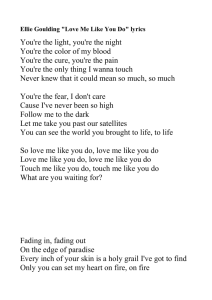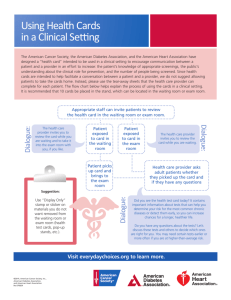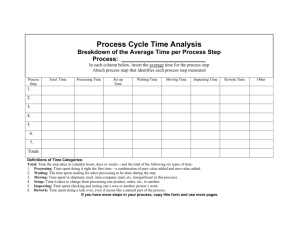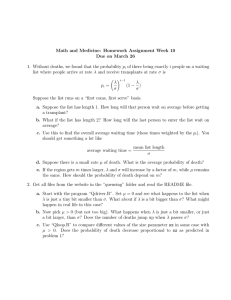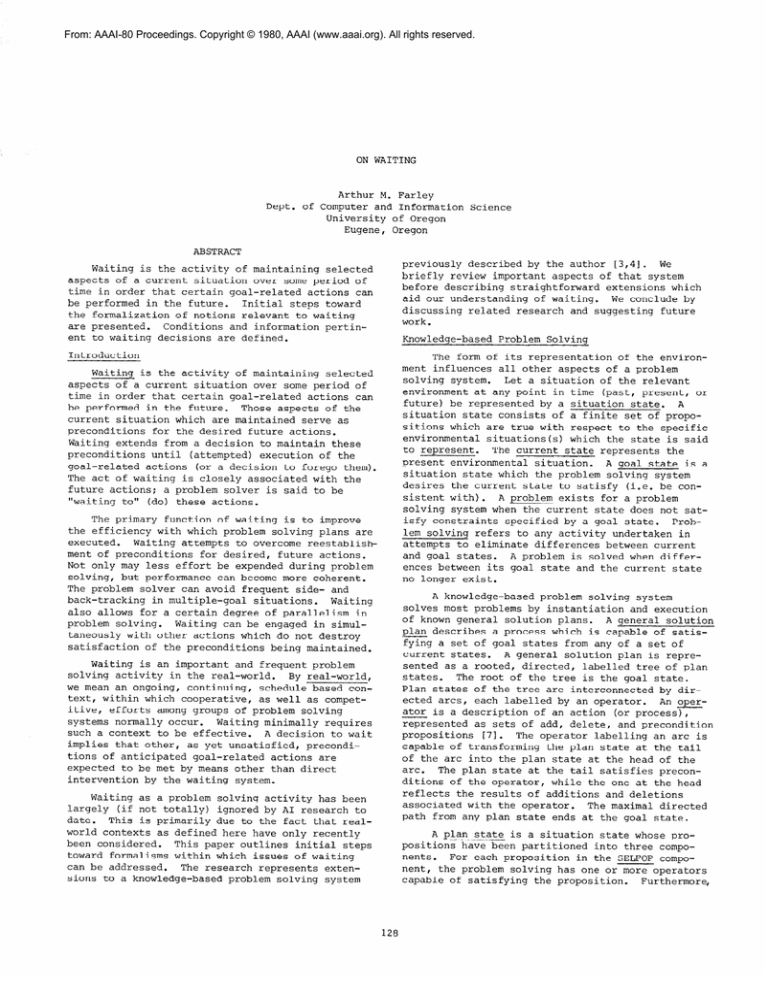
From: AAAI-80 Proceedings. Copyright © 1980, AAAI (www.aaai.org). All rights reserved.
ON WAITING
Dept.
Arthur M. Farley
of Computer and Information
University of Oregon
Eugene, Oregon
Science
ABSTRACT
Waiting is the activity of maintaining
selected
aspects of a current situation over some period of
time in order that certain goal-related
actions can
be performed in the future.
Initial steps toward
the formalization
of notions relevant to waiting
Conditions and information pertinare presented.
ent to waiting decisions are defined.
Introduction
Waiting is the activity of maintaining
selected
aspects of a current situation over some period of
time in order that certain goal-related
actions can
be performed in the future.
Those aspects of the
current situation which are maintained serve as
preconditions
for the desired future actions.
Waiting extends from a decision to maintain these
preconditions
until (attempted) execution of the
goal-related
actions (or a decision to forego them).
The act of waiting is closely associated with the
future actions; a problem solver is said to be
"waiting to" (do) these actions.
The primary function of waiting is to improve
the efficiency with which problem solving plans are
executed.
Waiting attempts to overcome reestablisk
ment of preconditions
for desired, future actions.
Not only may less effort be expended during problem
solving, but performance
can become more coherent.
The problem solver can avoid frequent side- and
back-tracking
in multiple-goal
situations.
Waiting
also allows for a certain degree of parallelism
in
problem solving.
Waiting can be engaged in simultaneously with other actions which do not destroy
satisfaction
of the preconditions
being maintained.
Waiting is an important and frequent problem
solving activity in the real-world.
By real-world,
we mean an ongoing, continuing,
schedule based context, within which cooperative,
as well as competitive, efforts among groups of problem solving
systems normally occur.
Waiting minimally requires
such a context to be effective.
A decision to wait
implies that other, as yet unsatisfied,
preconditions of anticipated
goal-related
actions are
expected to be met by means other than direct
intervention by the waiting system.
Waiting as a problem solving activity has been
largely (if not totally) ignored by AI research to
date.
This is primarily due to the fact that realworld contexts as defined here have only recently
been considered.
This paper outlines initial steps
toward formalisms within which issues of waiting
can be addressed.
The research represents extensions to a knowledge-based
problem solving system
previously described by the author [3,41. We
briefly review important aspects of that system
before describing straightforward
extensions which
We conclude by
aid our understanding
of waiting.
discussing related research and suggesting future
work.
Knowledge-based
Problem
Solving
The form of its representation
of the environment influences all other aspects of a problem
Let a situation of the relevant
solving system.
environment at any point in time (past, present, or
future) be represented by a situation state.
A
situation state consists of a finite set of propositions which are true with respect to the specific
environmental
situations(s)
which the state is said
to represent.
The current state represents the
present environmental
situation.
A goal state is a
situation state which the problem solving system
desires the current state to satisfy (i.e. be consistent with).
A problem exists for a problem
solving system when the current state does not satisfy constraints
specified by a goal state.
Prohlem solving refers to any activity undertaken in
attempts to eliminate differences between current
and goal states.
A problem is solved when differences between its goal state and the current state
no longer exist.
A knowledge-based
problem solving system
solves most problems by instantiation
and execution
of known general solution plans.
A general solution
plan describes a process which is capable of satisfying a set of goal states from any of a set of
current states.
A general solution plan is represented as a rooted, directed, labelled tree of plan
The root of the tree is the goal state.
states.
Plan states of the tree are interconnected
by directed arcs, each labelled by an operator.
An operator is a description
of an action (or process),
represented as sets of add, delete, and precondition
propositions
[71. The operator labelling an arc is
capable of transforming
the plan state at the tail
of the arc into the plan state at the head of the
The plan state at the tail satisfies preconarc.
ditions of the operator, while the one at the head
reflects the results of additions and deletions
associated with the operator.
The maximal directed
path from any plan state ends at the goal state.
A plan state is a situation state whose propositions have been partitioned
into three components.
For each proposition
in the SELFOP component, the problem solving has one or more operators
capable of satisfying the proposition.
Furthermore,
the system normally expects (prefers) to satisfy a
SELFOP proposition
itself by executing one or the
operators.
For each proposition
in the OTHEROP
component,
(costly) operators may exist allowing
the system to satisfy the proposition
itself, but
the system normally expects the proposition
to be
satisfied by other problem solving systems in the
environment.
Finally, for each proposition
in the
NOOP component, neither the system itself nor any
other problem solving system has control over satisfaction of the proposition
(i.e., weather conditions).
plan reflecting real-world time constraints
(a
scheduled plan), the NOOP component of a plan state
will contain one or both of the propositions
ISNOWBEFORE(t)
and ISNOWAFTER(t),
where t is a time
specification.
The truth of a time proposition
is
determined relative to the current time, considered
to be an ever present aspect of the current state.
Time propositions
of plan states derive from time
constraints placed upon goal state satisfaction.
They are propogated to other states (rules) of a
scheduled plan, with time parameters adjusted to
reflect time estimates for traversed operators.
Though the structure of a general solution plan
the plan as
is made clear by its tree, representing
a production system can facilitate its execution.
A production system [61 is a collection of
condition-action
pairs called rules.
In the production system representation
of a general solution
plan, each
plan state serves as the condition part
of a rule whose action part is the operator labelling the arc leaving that plan state.
In [41,
the
author describes how this representation
can be
useful in a selective approach to coordinating
the
execution of multiple plans.
Rules from general
solution plans associated with as yet unsatisfied
goals are combined to form one production
system.
A rule classification
scheme is defined which provides for the avoidance of most inter-plan conflicts while allowing for responsive, efficient
For example, a goal state is
problem solving.
classified as ungS;ounded if it denies satisfaction
of conditions from a (critical) rule of another
plan (in a conjunctive goal set).
Rules from plans
for ungrounded goal states are not executed until
conflicting plans have been completed.
In a scheduled plan, time propositions
alone
may determine the relevancy status of rules.
Rules
which are irrelevant solely due to unsatisfied time
constraints have their NOOP components classified
as early or late, depending upon which time proposition is not satisfied.
A rule with early NOOP
component, but which is otherwise ready, is classified as imminent.
Whenever an imminent rule exists
during plan execution, the problem solving system
may consider waiting while time passes until the
rule becomes relevant and can be fired.
One source
of imminent rules are overestimations
of time requirements for completed, prior operations from a
scheduled plan.
For example, you estimate a 30
minute drive to a shopping mall; but it only takes
The rule by
15; you arrive before the mall opens.
which you would enter the mall is imminent.
Another situation which may prompt waiting is
the existence of a dependent rule.
A relevant,
self-satisfied
rule corresponding
to a plan state
whose OTHEROP component is not satisfied is ClaSSiWhenever a dependent rule exists
fied as dependent.
during plan execution, the system may consider
waiting until the expected (necessary) assistance
arrives and the rule can be fired.
Dependent rules
can often arise during cooperative problem solving
For example, you are painting a house
efforts.
with a friend and turn around, expecting him to
hand you a new can of paint, but he hasn't finished
opening it. The rule by which you would take the
paint is dependent.
Waiting
We are concerned here with the control of waiting during plan executions
by knowledge-based
problem solving systems operating in real-world conWe first consider the question: what situtexts.
ations trigger consideration
of waiting?
A rule is
self-satisfied
if all propositions
in its SELFOP
component are satisfied.
Whenever a self-satisfied
rule exists during plan execution, a problem solving system may consider waiting, maintaining
those
conditions of the rule it has satisfied until the
rule can be executed.
A rule whose conditions are
completely satisfied, and thus can be executed
during a current system cycle, is classified as
Ready rules can suggest waiting.
ready.
The system may wait to execute one ready rule, selecting
another which leaves the rule ready (through conflict resolution).
Finally, rules which have only their SELFOP
component satisfied are classified as needy.
Needy
rules arise frequently when coordinating with public, problem solving support systems, such as mass
transportation.
To board a bus, a problem solver
must be at a bus stop (SELFOP), at the scheduled
time (NOOP), with the bus being at the stop
(OTHEROP) . If a problem solver arrives at a stop
five minutes early, the rule by which it boards the
bus is needy.
During plan execution, a rule corresponding
to
a plan state whose NOOP component is not satisfied
is classified as irrelevant.
Such a rule can only
fire if uncontrollable
aspects of the environment
change favorably.
An irrelevant rule which is
otherwise satisfied is a contingent rule.
Being
self-satisfied,
contingent rules suggest consideration of waiting.
Any NOOP condition must be satis
fied occasionally,
otherwise a rule would be fantasy and not considered part of a problem solving
system's executable plans.
An important class of NOOP propositions
are
those which deal with time.
In a general solution
129
research on plan formulation
[51. It appears to be
just as fruitful a source of ideas on plan execuMeeting schedules
tion and the role of waiting.
and office hours, going shopping, and using public
transportation
are actions which require frequent,
even planned, waiting.
A simulation to evaluate
various waiting policies is planned.
Given the existence of a self-satisfied
rule,
what information
is pertinent to subsequent waiting
decisions?
With each self-satisfied
rule, the problem solving system can associate three values: a
waiting period, a set of compatible rules, and a
set of contending rules.
The waiting period is an
estimate of the length of time before a selfsatisfied rule will become ready.
A compatible
rule is a ready rule which requires less (estimated) time than the waiting period, and would not
destroy satisfaction
of the self-satisfied
rule's
conditions.
A contending rule is a ready rule
from another scheduled plan which would destroy
the other's self-satisfaction,
requires more time
than the waiting period, but will become classified
late if it is not fired within the waiting period.
Determining
these two sets of rules would not
require dramatic additional computational
effort.
They only contain ready rules, rules which the
system always determines before selecting the next
rule to execute.
REFERENCES
A simplest policy for waiting can be stated in
terms of these two sets of rules.
If there is a
contending rule associated with a self-satisfied
rule, do not wait; otherwise wait, firing a comThough this may propatible rule, if any exist.
duce effective behavior in many circumstances,
a
moment's thought suggests further considerations.
A goal state is nearby to a self-satisfied
rule if
time estimates indicate that the system could
satisfy the goal state and reestablish conditions
of the self-satisfied
rule within the expected
A more complex waiting policy
waiting period.
could have a system elect to wait in the face of
contending rules, especially when compatible rules
and/or nearby goal states allow active waiting.
Relative importances of goal states would influence
such a policy.
Finally, rather than an expected
function
waiting period, a cumulative probability
representing
the likelihood that a self-satisfied
rule will be able to fire within a given period of
time could add further sophistication
to waiting
policies.
Conclusion
Research on distributed problem solving has
used waiting as a coordination primitive
[ll.
Coordination
is realized in our model through
ungrounded goal states and unsatisfied OTHEROP components.
Postponing actions until others have
completed their responsibilities
may or may not
result in waiting as defined here.
Research on
medical diagnosis has dealt with time duration
propositions
in rule conditions
[2]. These suspend
judgement until time lends its support,
Again,
time-based postponement
differs from issues of
waiting addressed here.
In this paper we have specified formalisms
which add waiting to the repertoire of capabilities
of problem solving systems dealing with real-world
contexts.
An (incomplete) set of conditions under
which waiting may be reasonably considered are
defined, as are aspects of the subsequent waiting
decision process.
We are continuing investigation
of waiting by considering a particular context -that of satisfying a set of work and personal goals
on a given day within an office and city setting.
This context has received attention in recent
130
r11
'Hierarchical planning in a
Corkill, D.
distributed
environment:,
Proceedings
IJCAI-79,
Tokyo, 1979, p. 168-175.
[21
Fagan L. etal., "Representation
of dynamic
IJCAI-79,
clinical knowledge", Proceedings
Tokyo, 1979, p. 260-262
r31
"The coordination
Farley, A.M.
goal satisfaction',
Proceedings
1977, p. 495.
II41
Farley,
problem
actions
August,
[51
Hayes-Roth, B. and Hayes-Roth F.
"A cognitive model of planning", Cogntive Science,
3 (19791,
pp. 275-310.
[61
Newell, A. and Simon, H.A.
Human Problem
Englewood Cliffs,
Solving, Prentice-Hall:
NJ, 1972.
[71
Sacerdoti, E.D.
"Planning in a hierarchy of
Intelligence,
abstraction
spaces", Artificial
5, 1974, pp. 115-135.
of multiple
IJCAIS, MIT,
A.M.
"Issues in knowledge-based
solving" to appear in I.E.E.E. Transon Systems, Man, and Cybernetics,
1980.


